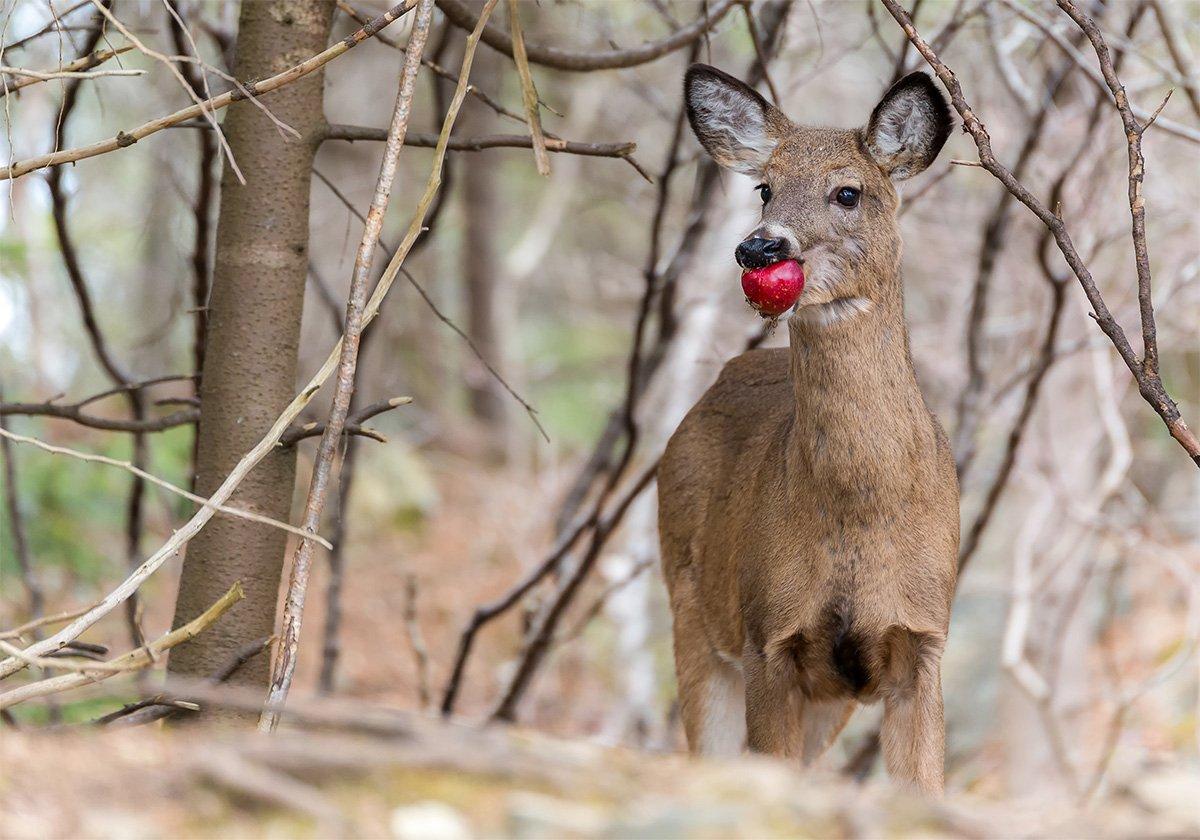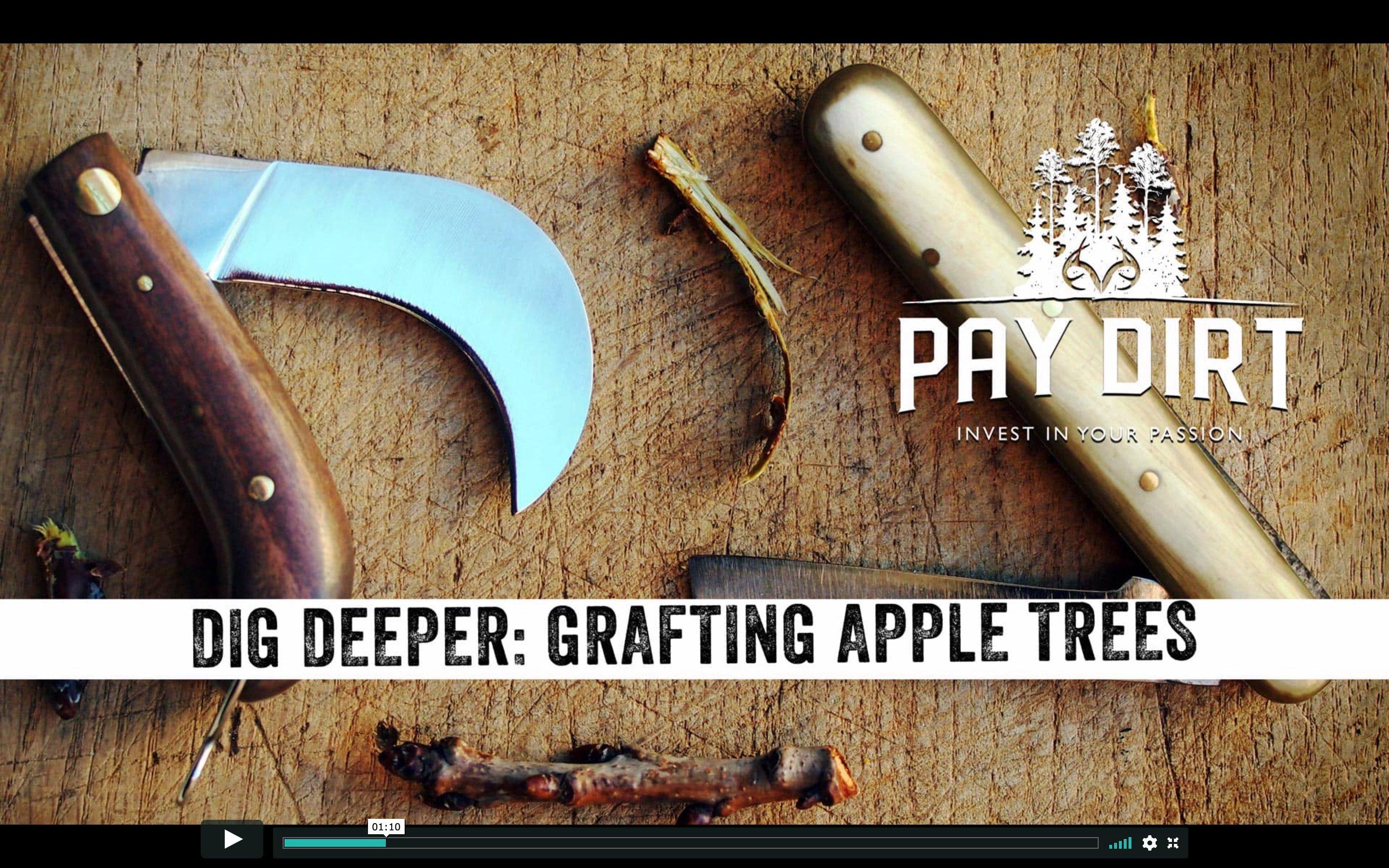Lush fields of clover, alfalfa and brassicas aren’t the only crops that will hold deer on your property. Once established, fruit trees can produce highly attractive forage for 40 years or more.
The right trees produce edible fruit throughout the entire hunting season, drawing deer from a distance and holding them on your property.
Select the Right Tree
Deer will readily consume apples, pears, plums, persimmons, and mulberries. By planting a variety of trees, you can ensure at least one ripe food source throughout the season. Most fruit varieties are available in dwarf, semi-dwarf and standard sizes.
Dwarf varieties mature around 8- to 10-feet tall and wide. They’re suitable for small spaces and can stand up to high winds better than larger trees. Their height also makes it easier for deer to reach fruit before it falls to the ground, though the small size of these trees limits fruit production.
While a deer orchard on your property might cost a bit more up front than traditional food plots, the long-term payoff and ease of maintenance is worth the price.
Most semi-dwarf trees average 12- to 15-feet tall and wide, and will produce roughly twice as much fruit as a dwarf variety while remaining relatively wind resistant and easy to maintain. Though they take up more space than dwarf trees, the hybrids can still be planted in tight clusters, making them ideal for most farms.
Standard-sized trees can reach 25 feet in both height and width. While they produce the most fruit per tree, standard varieties are also more susceptible to wind damage and take the longest to produce fruit. They fit best in large spaces with a nearby windbreak, like larger timber or hilly terrain.
Pick an Orchard Site
Fruit trees need sunlight to produce, so open field edges (preferably near bedding areas or food plots) will be the most productive locations. Like any crop, it’s always best to get your soil tested before planting your orchard. Fruit trees grow best in well-drained, fertile soil with a pH of between 6.0 and 7.0. If you soil pH falls outside this range, it can be corrected to make your trees more productive.
Stark Brothers Nursery, one of the nation’s largest fruit tree producers, recommends digging the hole for your fruit tree as much as three times wider and deeper than your root ball. The loose soil can then be mixed with compost, rotted (never green) manure, or other organic material, then backfilled to provide a loose, fertile rooting space for the new tree. Trees should be planted at or below the root graft, or roughly the same depth they are potted at the nursery. Planting too deep will stunt the growth of your tree and delay fruit production.
For most of the country, early spring is the perfect time to plant fruit trees. Wait until the risk of hard freezes subsides in your area, and plant your saplings when the soil isn’t too wet and heavy. Space the saplings roughly twice the distance as the expected height of the mature tree.
Choose the Right Saplings
There are three basic fruit tree options for planting.
The easiest, and most likely to thrive, are potted trees from a nursery. Potted trees are generally the largest and fastest to mature of all the young trees. The only drawback is the cost: These are the most expensive, normally ranging from $30 to $100 or more depending on the size and variety you select.
Much more affordable – but smaller and slower to mature – are bare-rooted seedlings. These will run $10 to $40 dollars depending on size, variety and the quantity you order. Bare-rooted seedlings should be planted as soon as possible after you get your hands on them. If you can’t plant them right away, store the seedlings in a shaded area and keep the roots moist, but not wet.
The most economical method of obtaining fruit trees is to purchase root stock and graft your own seedlings from sprouts off of an existing tree. Root stocks can be purchased for as little as $1, and sprouts off existing trees are free, making self-grafting your own seedlings the way to go if you don’t have a budget or want to plant so many trees that buying them all is out of the question.
To graft a tree, cut a section of the scion (the sprout from the existing tree) into a wedge shape and insert into a slit made in the root stock. The graft is then wrapped tightly with a rubber band until the two sections have grown together. (Learn how to graft fruit trees right here.)
Don’t forget: Many fruit varieties, particularly apples, require a tree of another variety nearby to cross pollinate. When choosing varieties, check the tag on your seedling to see if it requires a pollinator or is self-pollinating. Plant your trees in clusters to make pollination by bees and other insects more reliable.
Protect Your Investment
Once you have your trees or seedlings in the ground, it’s important to take care of them. Rabbits, deer and other wildlife are attracted to the tender browse provided by young fruit trees, but a section of black corrugated drain pipe, slit down one side and wrapped around the seedling, will protect them from damage.
Young trees are also attractive to browsing deer and late-summer bucks looking to polish antlers as their velvet sheds. A wire fence around young trees will prevent damage or destruction to your orchard. Drive three or four metal T posts in either a triangle or square pattern around the tree and wrap the posts with fencing wire. Or find a section of hog panel, available at your local farm store, and bend it to form a circle around the tree.
Trees should be watered after planting and during dry periods for the first year or two. Trimming or spraying any grass or weeds around the base means less competition to the tree for water and nutrients. Stark Brothers recommends feeding fruit trees once or twice each year. Fertilize in the spring with a balanced fertilizer like 10-10-10 or 12-12-12 for optimum growth and fruit production.
To reduce the possibility of wind damage and increase fruit production, prune your fruit trees yearly. Cut away any crossing branches, branches that grow back into the center of the tree or those that grow straight up. A properly pruned fruit tree will have layers of horizontal branches with plenty of open space to allow sunlight to reach all the limbs.
While a deer orchard on your property might cost a bit more up front than traditional food plots, the long-term payoff and ease of maintenance is worth the price. A variety of fruit ripening throughout the fall and winter will keep deer coming back to your place – and make it easy for you to choose a stand location.













